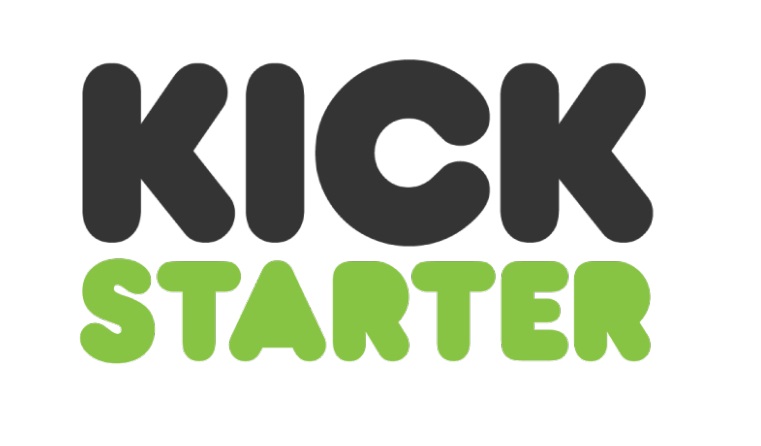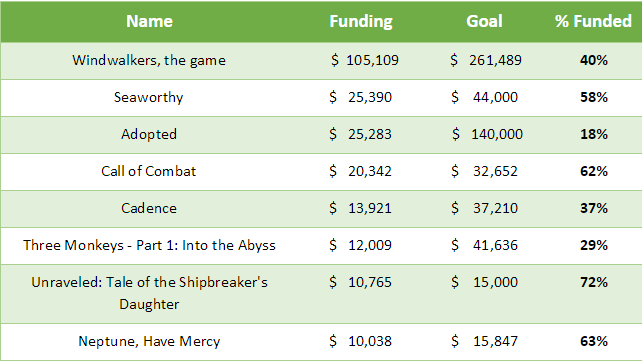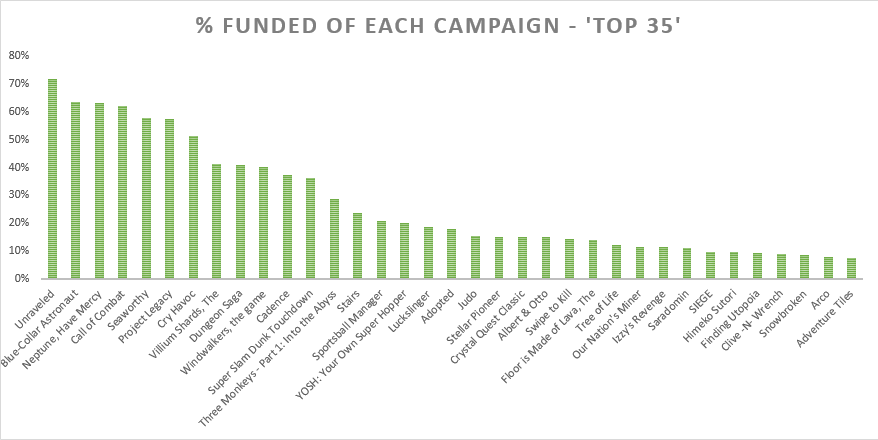105 videogame campaigns were unsuccessful on Kickstarter this month as opposed to the 35 successes. Both of these numbers are up from February, however not to the same degree. February had 70 failures with 28 successes. So basically, when analysts discuss the most successful months (April being one of them!) they’re not kidding, but the percentage of success will likely not stray too far, while unsuccessful campaigns will no doubt clutter up everything. While there were some great looking campaigns (aside from the few we’ve chosen to highlight here) the trend of low information campaigns also continued. By low info we mean campaigns which offer something along the lines of one or two paragraphs of information and no screenshots. There were 33 of those as opposed to 20 from last month. It would be amazing if people could stop doing this, but unfortunately it seems a given in the crowdfunding space.
Seven campaigns were canceled this month by their developers which is an increase over the three from February. The most interesting aspect of this is one I’ve rarely seen before. Multiple folks canceled their campaigns after they were fully funded. These campaigns were Animus and Jack Stone Puzzle Galaxy. It’s impossible to know why both were canceled, but my best guess is the developers didn’t feel they raised enough money. This seems especially true in the case of Jack Stone Puzzle Galaxy which asked for a mere $30. At least in this one’s case there was only one backer. The Animus backers on the other hand were a bit perplexed until they received word that the developers underestimated the time and effort to make the game a realy and decided to put it on hold indefinitely. With that said, it is probably a good thing they canceled the campaigns otherwise these games may have become totally MIA.
Failed campaigns asked for a little over five million dollars this month. For reference, last month’s total was two million. If it had not been for PvE MOBA asking for two million itself things would have been closer between the months, despite the huge increase in total campaigns. Of course, total asking price wasn’t met, so how much did all 106 Kickstarters actually raise? $310,148, or a measly 6% of their collective goals. Between every single campaign, average funding goals came out to $48,895. Removing the one ridiculously excessive two million goal this gets chopped down a bit to an average goal of $30,134. That doesn’t change the fact that average actual funding still came out tremendously low at $2,954. It’s worth noting this is an almost $2,000 increase from February, though.
When you look at the average goal to funding ratio it ends up at a paltry 6%, which is only a tiny increase over February’s 5.4%. These percentages alone hardly tell the full story. As is evidenced by the previous chart, a few campaigns did quite well for themselves to raise over $10,000. But this isn’t the norm for failed ones. As opposed to last month where only one project was not backed by anyone at all, March saw 15 with zero backers. Then there were 33 campaigns raising over $100. Therefore, of 105 campaigns in all 48 raised a measly amount. Thanks to a few well-backed campaigns, average backers calculates to 56. There were 5978 backers who pledged to failed projects this month, up from 1805 last month. As more campaigns launch you’re increasingly likely to back something which doesn’t turn out as a success.
A bit of data which is of personal interest to me revolves around the number of project leads who have hit up Kickstarter in the past. There were 20 folks this time who had utilized the site before, which is actually a decrease from February’s 14 when you consider how many more campaigns launched this month. With that said, I’ve noticed some people who habitually create the same campaign (or very similar ones) over and over without any attempt to fix them. Will they ever stop? There’s probably no reason for Kickstarter to intervene as long as they aren’t “hurting” anybody. One habitual project creator actually did succeed this month, which is worrying, but that is not to be discussed here. Perhaps with enough further research you may see an article on this topic in the near future!
There were 41 campaigns in March which were seeking funds in a non-US $ currency. This is another bit of information which continues to pique my interest. Why is it that these campaigns succeed on a less frequent basis? Is it because many of these regions are new to Kickstarter and then going through the same growing process that US consumers had to (wherein folks flood the site with half-formed ideas due to the “gold rush” mentality)? Is there more at play? Personally, I’m of the opinion that there is a lot more at play than simply low info campaigns causing this effect. Unfortunately answering such questions with any degree of certainty requires more data gathering. No matter what the cause is, potential project leads need to be aware that the cards may be stacked against them if they’re not funding with USD. These folks may want to consider incorporating in the United States so they can raised funds in $ instead, even if that is a bit iffy to do.
Because April has long been considered a huge month for crowdfunding we should expect to see an even larger amount of campaign failures next time around. Just how much will things increase is anyone’s guess, but I’m strangely looking forward to it. No, that’s not because I thrive off the failure of others or something. It simply provides a lot more data to work with! If you or your friends have an unsuccessful campaign know that you’re not blocked from ever trying again. There is precedent for campaigns succeeding on a second try. Of course, this requires a renewed effort, improved presentation, and ensuring that the word gets out about your campaign.
Looking for more Kickstarter data analysis? Check out our monthly recaps here, as well as some of our Kickstarter analysis articles.






i still get very puzzled how some games do well and others do not i mean often you can see something that i think that will put people off but then i see a project that has no issues i can see and yet does not do that well
There are tons of factors that play out in these thing: advertisement, confidence in the project, know developer, etc, etc. Plus people are more wary about crowdfunding campaigns due to high profile failures.
One game called the chainsaw incident i really thought would be a success as it looked awesome but they made a flaw in the initial launch of the project….no matter how much you donated you did not get a finished game they did rectify it but was to late. Also there was a game called wave of darkness nearly finished on kickstarter i really did not think would make it’s goal as there previous game to be polite was not that good but seems like they had a few really big donations….the cynical me finds that a bit suspicious
You bring up a good point! To me, it seems that Kickstarter (and crowdfunding in general) is still a bit of a gamble. Some really amazing games have failed and some not-so-awesome ones have succeeded. Even the biggest crowdfunding fans and analysts cannot predict with 100% certainty what will happen. I sure wish we could, though!
I don’t understand how anyone could put up a kickstarter for a game and only have a couple of sentences describing the game or putting up a Kickstarter without a pitch video. I mean surely something must look wrong to these people? They might as well be titling their project “Don’t back us, we suck!”
It’s really confusing. If I could, I’d ask these folks what they were thinking, but they probably really aren’t. They just hear that Kickstarter is a place where people will “give you free money,” do no research at all, and then get confused when their one sentence campaign doesn’t generate thousands of bucks.